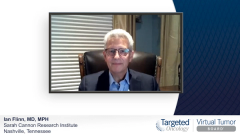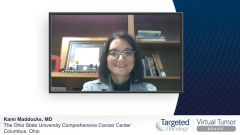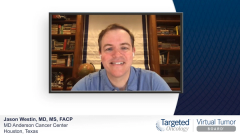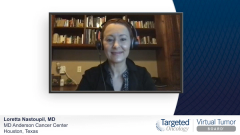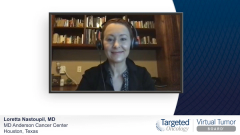
Case 2: Phase 2 L-MIND Clinical Trial for Relapsed/Refractory DLBCL
Ian Flinn, MD, MPH: As you mentioned, there are a number of therapies if you look at NCCN guidelines [National Comprehensive Cancer Network] ranging from GemOx [gemcitabine and oxaliplatin] to, and rituximab, to BR [bendamustine] plus polatuzumab. There are a bunch of other older chemotherapy regimens that are not very realistic such as using the very aggressive regimens and dose=adjusted EPOCHs etoposide, prednisone, vincristine (Oncovin), cyclophosphamide and doxorubicin hydrochloride (hydroxydaunorubicin hydrochloride)], EPOCH plus rituximab. And then some of the newer agents that we’ve already talked about.
This patient, because it was deemed that this patient was not really a candidate for CAR [chimeric antigen receptor] T cells went on to receive tafasitamab and lenalidomide. Tafasitamab and lenalidomide was recently FDA approved. Tafasitamab is a CD19-directed antibody that has had the Fc enhanced, Fc portion of the antibody enhanced to improve ADCC [antibody-dependent cell-mediated cytotoxicity] as well as ADCP [antibody-dependent cellular phagocytosis]. We know that it works well in combination with lenalidomide, which of course has a number of effects, including direct cells, but that also with the effect on the immune system to achieve a NK [natural killer] cell activation.
There was a study that led to the approval of this combination of tafasitamab and lenalidomide. It was known as L-MIND [NCT02399085]. It was a single-arm phase 2 trial that looked at the combination of this drug—tafasitamab, given days 1, 8, 15, and 22, in combination with lenalidomide at 20 mg PO, days one through 21, similar to what you might expect with an R2 regimen. And then, of course tafasitamab was given less often for the monthly, or days 1 and day 15 for the next cycles through cycle 12. And then patients went on to receive single-agent tafasitamab after that and lenalidomide was dropped out.
It was an interesting study. The patients I failed to mention that were eligible for this trial were patients who had one to three prior regimens, they couldn’t have been eligible for a transplant, they couldn’t have been primary refractory. Not the worst of the worst but patients who had, truly there’s a need here for new agents. And in this study there was an overall response rate of about 60% and many of these patients had a complete remission, 43% of the patients achieved a complete remission.
And the duration of response in the progression-free survival will also, were also impressive with progression-free survival about a year, and overall survival about at 18 months, and 64% of patients were still alive. This is better than you might expect with what we saw with the SCHOLAR-1 data, but this isn’t the same patient population that we saw in that dataset as well, definitely not the very refractory patients that went on this.
The adverse event profile is not that dissimilar that you might see with R2 regimen. And of course there’s the hematologic toxicity that’s generally seen with lenalidomide. But beyond that it was a well-tolerated regimen. The most common nonhematologic toxicities were fatigue and diarrhea. Again, things that you might see with the addition of lenalidomide to pretty much any antibody.
So the number of patients that had serious adverse events was about half of patients, not unexpected in this patient population with relapsed and refractory disease. And some of these were thought to be related to the therapy, but that was a minority of the adverse events.
Transcript edited for clarity.



